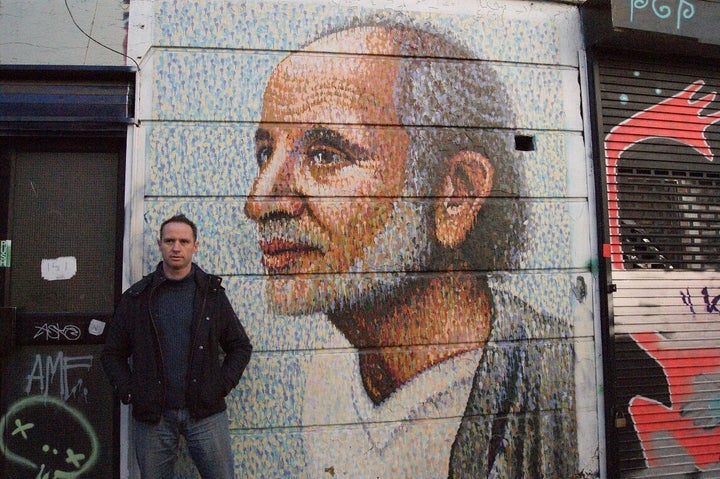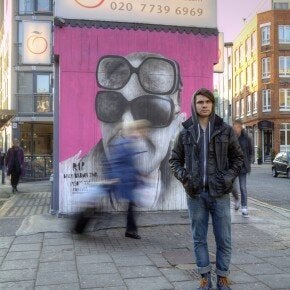Street art is often political and satirical but is it ever personal? Banksy is known for his illusive identity but other London street artists use art to express their identities. Three of them have spoken to the Huffington Post about the intimate experiences that inspired their work...
James Cochran

Most people walk past homeless people - James Cochran paints them. The innovative street has painted rough sleepers all over the world and his work can be seen in London, Paris, New York and Adelaide.
But what triggered his fascination with homelessness? James Cochran's interest goes beyond artistic curiosity. As a 16-year-old boy he says he slept rough on the streets of Adelaide, where he grew up, "back in the days when graffiti was raw and underground".
Cochran left home because of family issues saying life on the street suited his lifestyle of painting every night. The young graffiti artist survived living off stolen food and sleeping on trains before being taken in by an elderly couple who found him sleeping on a shop floor.
"When I paint homeless people I tell them that I lived on the street. I want to show them that they can turn things around," he says.
Although he only slept rough for seven months, Cochran sees this as a pivotal in his development.
"It was about finding an identity as an adolescent and almost like a rite of passage as a graffiti artist", he says.
The 38-year-old street artist was born in England but his family moved to Australia when he was five and he studied Fine Art at the University of South Australia. He now has a gallery in Melbourne and Lille, and lives in a flat share in Shoreditch.
One of Cochran's better known portraits can be found just off Brick Lane on Bacon Street. He says he designed the piece to be deliberately ambiguous, "some people think it is of an Indian guy or a guru, others think it is a saint or a Greek philosopher."
"It was actually inspired by a real person, a homeless man I met in Paris while I was living there five year ago."
The Australian artist is influenced by pointillism, a form of art using dots of unmixed colour that from a distance fuse together. His signature style is dots created from drips of spray paint.
Cochran paints homeless people because, "you can see everything of their spirit. They are not layered in what society wants us to be".
Another portrait by Cochran can be spotted on Hackney Road. It was inspired by a homeless man from Adelaide called Rodney. The portrait shows the city coming out of Rodney's head and Cochran says that this, metaphorically, shows that the weight of the city is upon us.
James Cochran, who has painted four walls in London, is inspired by people on the "edge of society". And what does he want us to take from his portrait on Bacon Street?
"I want to convey human qualities. I did it in homage to the human struggle and the resilience of the human spirit."
Ben Slow

The above photo was taken by annar_50 (that is how he asked to be credited)
Cochran is not the only artist to paint real people on the streets of London. Next to his mural on Bacon Street is a portrait of an old man with the name Charlie Burns written beside it.
The artist who created it, 27-year-old Ben Slow thinks "there is always a story to tell in art".
"Charlie Burns is a local legend. He is 96-years-old and has lived in Bacon Street all his life," he says.
The old man has been dubbed 'The King of Bacon Street' because of his attachment to the East End. From running Repton Boxing Club to an audience with the Pope, where he was awarded a gold medal for charity work, Charlie Burns has seen and done it all. He has even spent time with the Kray Twins.
Street artist Ben Slow says he was charmed by Charlie's story insisting he didn't go looking for it but when he was introduced to Charlie he knew he wanted "to paint the old guy".
The young artist is passionate about "great characters" and he is proud that in his own little way he can do something good, commemorating people who deserve to be celebrated.
Slow's journey into mural art began when he moved to London four years ago after graduating from UCCA Canterbury.
He admits art school was "not much help artistically".
A short way away from Slow's homage to Charlie Burns is a powerful pink portrait the Kent-born artist has done in memory of a friend.
"That portrait is of Billy, a little Scottish guy in his fifties. He was a cheeky little sod but a lovely guy. The sort of person who I really didn't realise I would miss until he was gone," Slow explains.
Billy died in February of this year. The young street artist says he "did a lot of drugs but was an absolute sweetheart". A blog has been set up in memory of Brick Lane Billy with the creator describing him as "one of the greatest persons who roamed this earth".
"I think he died simply because he did too much for too long," Slow says.
Billy is wearing two pairs of glasses in the Bethnal Green Road portrait. Ben Slow explains he chose the image deliberately because it sums up Billy's character and he was always wearing crazy outfits.
The street artist did not want to paint "a straight forward portrait" but sought to create something a little different that would make people think.
In a world driven by "celebrity and false icons" Ben Slow is proud he can commemorate "people who deserve to be celebrated".
As for what other people think? "If people like my portraits enough to want to know more about the subjects I am painting then that is the biggest compliment I guess."
Stik
Street artists must consider the environment in which they work. If they paint a wall or doorframe their art should fit the space. One artist who testifies to this is Stik. He thinks "art has to make concessions to the form of the building on which it is made".
Stik refuses to say his exact age and reveals little about his past except that he has been painting for ten years and spent some time living on the streets. He now lives in Hackney Central.
During this formative period Stik says he saw the city in "three dimensions" looking for spaces to sleep within buildings he realised the city was both his home and his canvas.
Stik paints stick people saying he was inspired by the "simplicity of having something so simple that expresses a lot of emotion".
He likes street art because it is an immediate forum. "You can just go and do it and it is uncensored," he says.
However, when I meet him the energetic artist is unhappy because someone has drawn a penis on one of his artworks- the hazard of putting your art out there for everyone to see.
Stik talks about a mural he has done above the Foundry pub, a music and art venue on Great Eastern Street. "It was the hub of the underground art scene" Stick says, but sadly the building has now been closed down.
"I had one of my first shows at the Foundry. Tracey and Jonathan Moberly used to run it and they had a disclaimer about applying for the space. They said, crudely, we don't care who you are or what your art is about.
"You can put on a show here if you put your art up and take it down".
The Foundry was closed in May to make way for a hotel but people squatted the building in protest.
"Banksy did a piece of art on the back of the Foundry and the owners of the building covered it up to preserve it. They are taking the art and closing down the forum that made it", Stik says.
Stik's piece above the Foundry shows a figure against a blue background looking back into an empty space. This, the artist explained, is how he felt when the art space was demolished.